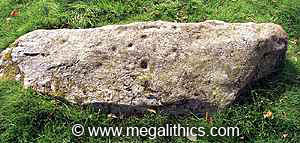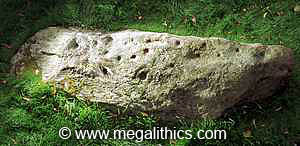| Stone at SSW | ||
 |
 |
|
|
Natural light. |
Low angle illumination. | |
Click on the small photos below for a high resolution picture (average size 85Kb).
Part of the phase two construction at Croft
Moraig was a kerbed rubble bank encircling the first "horseshoe" stone
ring.
On top of this bank at the SSW is a large stone with many cupmarks on its
exposed upper face. The stone is aligned
with the major southern moonset when
viewed from the centre of the stone ring and the stones of the inner ring are
graded up in height towards this stone.
Another stone from this phase is also cupmarked, the NE stone of the
"horseshoe" ring, the alignment in this case is said
to be with the midsummer sunrise above an horizon elevated by mountains.
Unfortunately our film of this stone was lost,
so no pics until our next visit to the region, sorry
:o(
The lunar alignment, cupmarking and
height grading of the phase two elements are all features that we
have seen many times in the recumbent
stone circles of Aberdeenshire.
Click on the small photos below for a high resolution picture (average size 85Kb)
While examining the NE inner circle stone,
we spotted these markings on the NE stone of the outer circle. We have
searched the literature covering rock art at Croft Moraig and can find no record
of these possible cupmarks.
Many sources, including the detailed excavation report on the site (Piggott
& Simpson, Proc Prehist Soc 37, p1-15, 1971),
mention cups on the supine SSW stone and the NE inner circle stone, but we
could find no accounts of rock art on
any of the stones of the outer phase 3 ring.
Although some of the marks are shallow, perhaps from weathering, at least two of
the pits looked like good
deep circular cupmarks to us. The clustering of the marks and their presence on
the NE stone, a position
corresponding to that of the cupmarked inner circle stone, adds further weight
to the idea that these indentations are
genuine cupmarks.